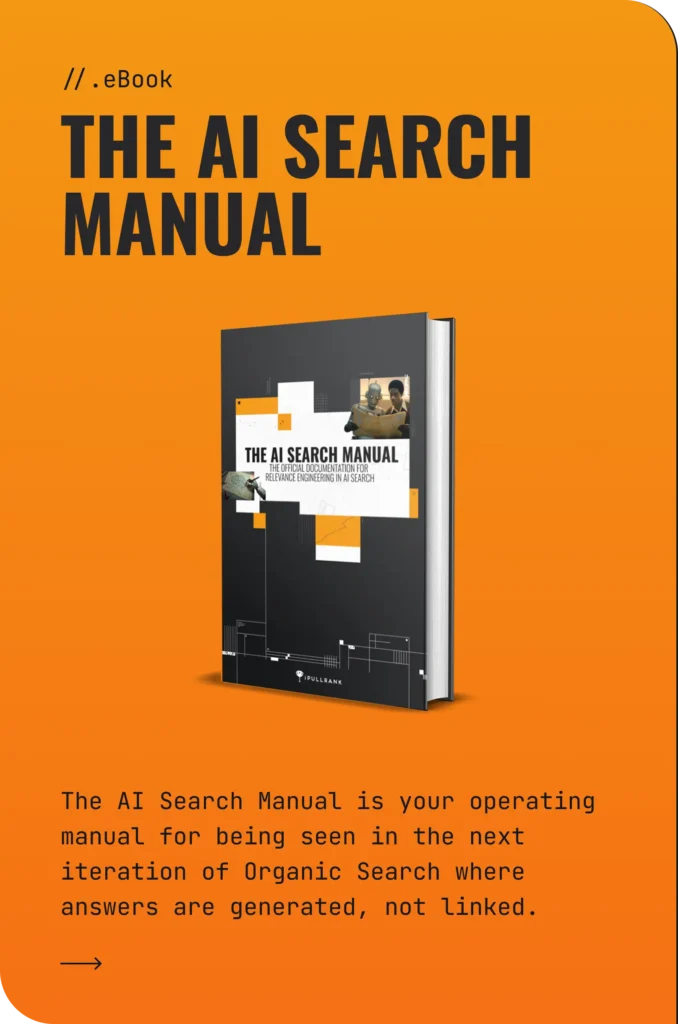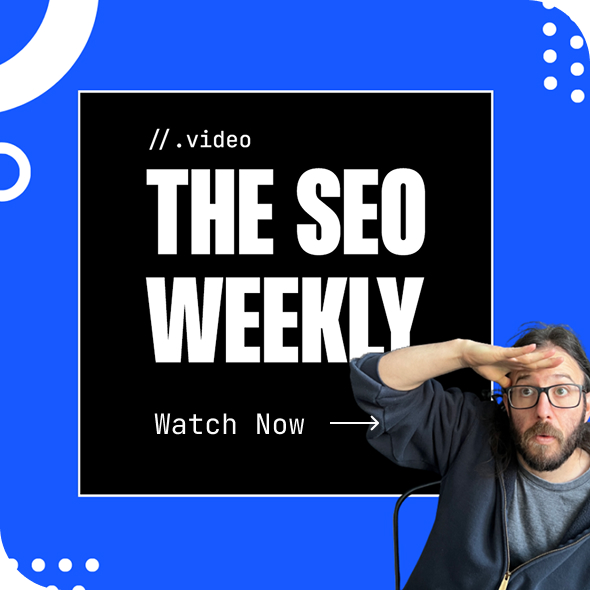Day 2 of SEO Week in NYC brought a fresh wave of insights, this time with a deep dive into the psychology behind search behavior and content strategy. For me personally, as a writer and content creator at heart, this was the day of content I was most highly anticipating, and it was better than I could’ve imagined.
From the very first session, it was clear: this wasn’t going to be just about tactics and tools. It was all about understanding people – how they search, what motivates them to click, and how evolving tech like AI is transforming that entire journey.

The day’s lineup was stacked with standout talks focused on how content strategies must evolve to meet the moment. Whether it was Dr. Ricardo Baeza-Yates unpacking the shift from semantic to predictive search or Talia Wolf showing how emotion-first CRO can drive real action, every speaker offered a unique lens into the human side of SEO. From vanity metrics to conversion-focused strategies, overlooked data to AI-powered content, each session reinforced the idea that understanding user psychology isn’t optional, it’s essential.
The content was as practical as it was thought-provoking. For anyone on board with understanding the importance of creating search experiences that resonate, convert, and endure, Day 2 was a masterclass.
And if that wasn’t enough, the night capped off with two incredible meetups:
- DemandSphere’s discussion on Technical SEO & LLMs
- SEOFOMO x Conductor’s meetup on trends, automation, and the future of SEO in 2025
Let’s just say: the conversations didn’t stop when the sessions ended.
Time to dive into the overviews; get ready, because there’s a lot to cover. After all, only the best of the best speak at SEO Week.
Jump to the speakers
Download all of the decks from our SEO Week day two speakers
From Semantic to Predictive Search: Evolution or Involution?

Dr. Ricardo Baeza-Yates, Chief Scientist at Theodora AI, delivered a comprehensive presentation comparing classic semantic search with modern neural AI-based approaches, emphasizing the challenges and risks associated with the latter.
He began by outlining the components of traditional semantic search, including ontologies, lexicons, linguistic rules, and semantic engines, while highlighting issues like language inequality and the limitations of current AI models. He then discussed the rise of neural AI since 2015, focusing on its pseudo-semantic nature and the potential pitfalls of relying on language models for search.
Dr. Baeza-Yates raised concerns about the misuse of AI, including bias, lack of diversity, and the erosion of critical thinking skills. He argued against anthropomorphizing AI and emphasized the importance of maintaining human oversight in AI applications. His talk concluded with a call for hybrid systems that integrate neural and classic semantic search methods, advocating for responsible AI development and usage.
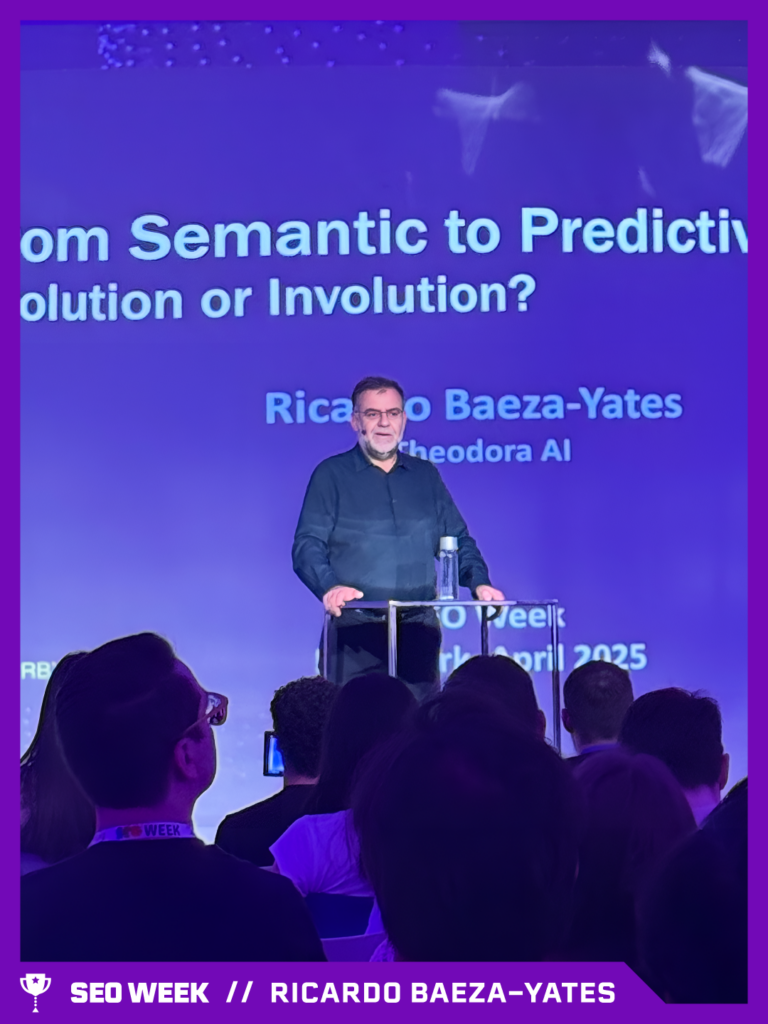
“Don’t talk about democratizing AI. What we are doing is increasing the digital gap in a very, very fast way.”
- Dr. Ricardo Baeza-Yates
Key points
- Access and Inequality: Over half the world’s population remains excluded from generative AI due to language barriers, limited internet access, and technological infrastructure gaps. This digital divide is deepening as AI capabilities evolve rapidly, disproportionately benefiting already-advantaged regions and communities.
- Understanding vs. Imitation: AI models don’t “understand” language, they mimic it. Their reliance on pseudo-semantic and statistical representations means they often miss context, struggle with common sense reasoning, and are vulnerable to hallucinations (fabricated outputs that appear credible). This makes them prone to delivering inaccurate or misleading information, particularly in nuanced or sensitive scenarios.
- Bias, Toxicity, and Ethical Challenges: Despite ongoing mitigation efforts, AI models still absorb and reflect the societal biases present in their training data. This includes gender bias, racial bias, and a failure to reliably detect hate speech or toxic content. These issues raise serious ethical questions, especially when AI is used in decision-making processes without sufficient oversight.
- Human Oversight and Cognitive Erosion: While AI offers immense productivity gains, it should remain firmly under human control. Anthropomorphizing these systems distorts their role and capabilities. Meanwhile, growing reliance on AI is contributing to the erosion of essential human skills like navigation, critical thinking, and writing—functions that are central to learning and communication.
- The Illusion of Intelligence: Generative AI creates an impressive simulation of intelligence, but that illusion can be dangerous. People often overestimate what these tools can do, leading to misplaced trust in outputs that may be biased, plagiarized, or outright incorrect. Remember: AI is a tool—not a mind—and it’s only as reliable as the systems and people guiding its use.
- Toward More Reliable AI: Hybrid approaches that blend neural models with traditional semantic search methods offer a promising path toward greater accuracy and trustworthiness. But this evolution must be intentional—centered on transparency, accountability, and preserving human agency in every AI-driven process.

Important Takeaway
Modern AI-based search systems offer powerful capabilities but pose significant risks – such as bias, misinformation, and skill erosion – highlighting the urgent need for hybrid approaches and sustained human oversight to ensure responsible and equitable use.
We now have a need for responsible AI by contrasting traditional semantic search with modern neural approaches, keeping in mind risks like bias, misinformation, and overreliance, while advocating for hybrid systems and human oversight.
Mini Glossary
- Semantic Search: A search method that focuses on understanding the meaning and context of words in a query, rather than just matching exact keywords.
- Ontology: A structured framework that defines relationships between concepts and categories in a particular domain (e.g., a medical ontology would relate symptoms, diseases, and treatments).
- Pseudo-Semantic: Refers to systems that appear to understand meaning but actually rely on statistical patterns and context, not true comprehension.
- Hallucinations (in AI): False or misleading information generated by AI that appears plausible but is factually incorrect or made up.
- Digital Divide: The gap between individuals or communities that have access to modern information technology (like AI and the internet) and those who do not.
F$%@ Traffic: Prioritizing Conversions Over Vanity Metrics

Bianca Anderson, Organic Growth Manager at hims & hers, delivered a talk centered around shifting the focus of SEO success from traffic to business impact. She highlighted the limitations of vanity metrics, such as traffic, in today’s evolving digital landscape, where AI overviews and declining click-through rates are reshaping SEO strategies.
Bianca introduced the “Heavy Hitters Framework,” a method to identify content that drives significant business outcomes. By emphasizing conversions over volume, this framework helps prioritize impactful content and communicate value to stakeholders. Drawing on her experience at HubSpot and Hims and Hers, she demonstrated how to implement this framework through practical use cases, including monitoring core systems, addressing performance dips, and conducting content audits.
“We still equate visibility with value... we're not quite ready to evaluate SEO success in this post-AI world."
- Bianca Anderson
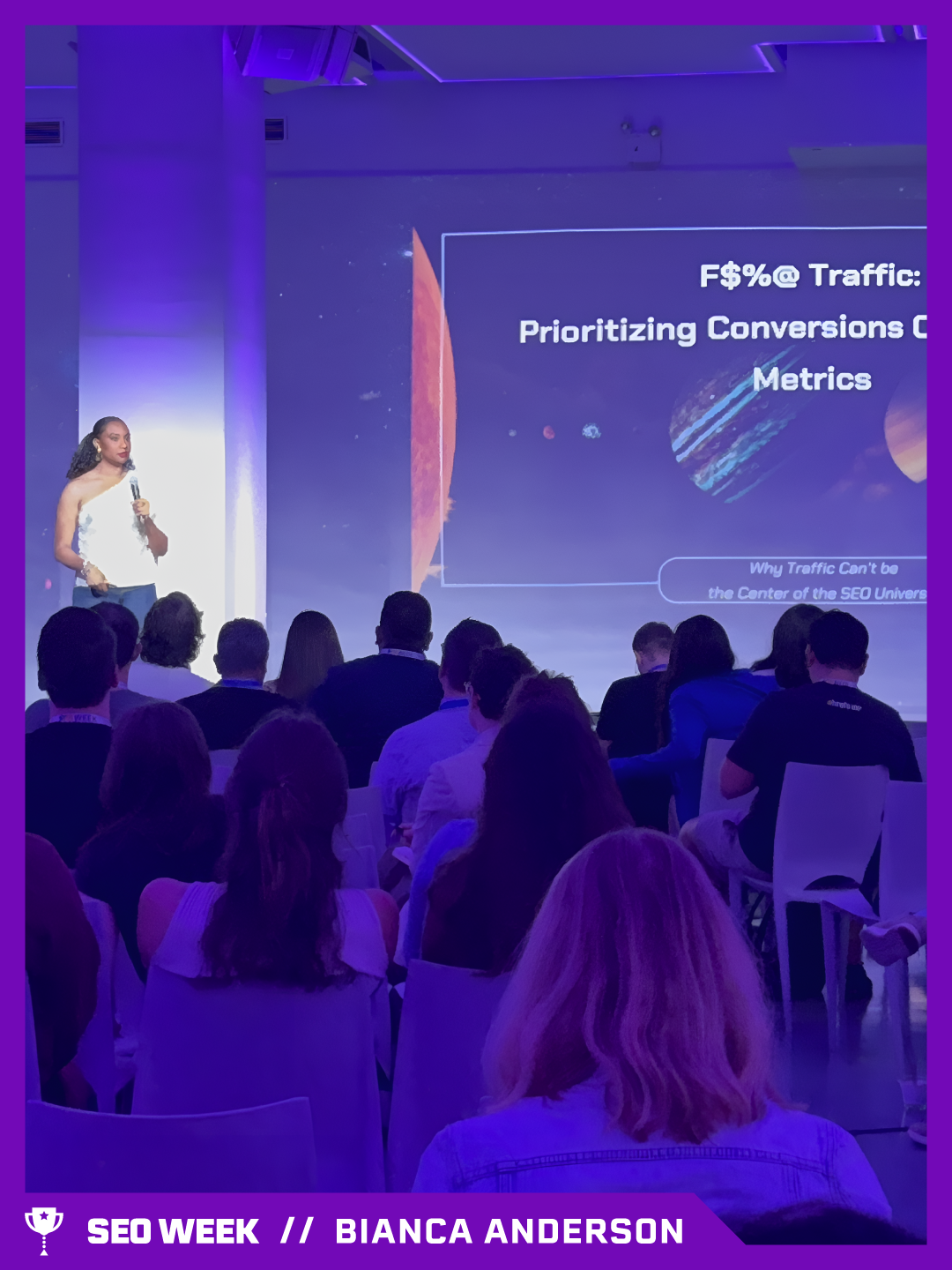
Key points
- Rethinking Success: From Traffic to Business Impact: Traditional SEO often revolves around traffic volume, but that metric alone doesn’t reflect true performance. A strategic shift – akin to a Copernican revolution – is needed: prioritize content that drives conversions and measurable business outcomes, not just pageviews. Traffic drops aren’t always red flags; they can be distractions if the content is still delivering impact where it counts.
- The Heavy Hitters Framework: Focus on the Few That Matter Most: Applying Pareto’s Principle, the Heavy Hitters Framework helps identify the 10–20% of content that disproportionately contributes to conversions. These pieces deserve special attention during audits and performance reviews. Monitoring them closely, especially during algorithm updates or volatility, ensures early detection of real problems—not just noise in the metrics.
- Cutting Through Vanity Metrics with Performance Tiers: Vanity metrics can lead teams astray, especially during sudden traffic shifts. By tiering content based on business value and conversion potential, teams can isolate “brown dwarfs”—low-traffic, high-converting URLs that represent optimization goldmines. This structured, data-driven approach clarifies priorities and aligns editorial efforts with outcomes.
- Diagnosing Systemic Volatility Without the Panic: Not all traffic changes indicate failure. Systemic volatility should trigger reflection, not reaction. Use “performance dip buckets” to categorize and understand underperforming content quickly. This enables responsive content governance that supports long-term growth rather than reactive short-term fixes.
- Optimizing for the AI Era: Mid-Funnel Content Is Key: With AI Overviews increasingly capturing informational clicks, top-of-funnel visibility is eroding. SEO strategies must shift focus to middle- and bottom-funnel content that survives the AI layer and drives real engagement. Weighted scoring models that normalize traffic and conversions help teams prioritize what matters in a search environment defined by AI.
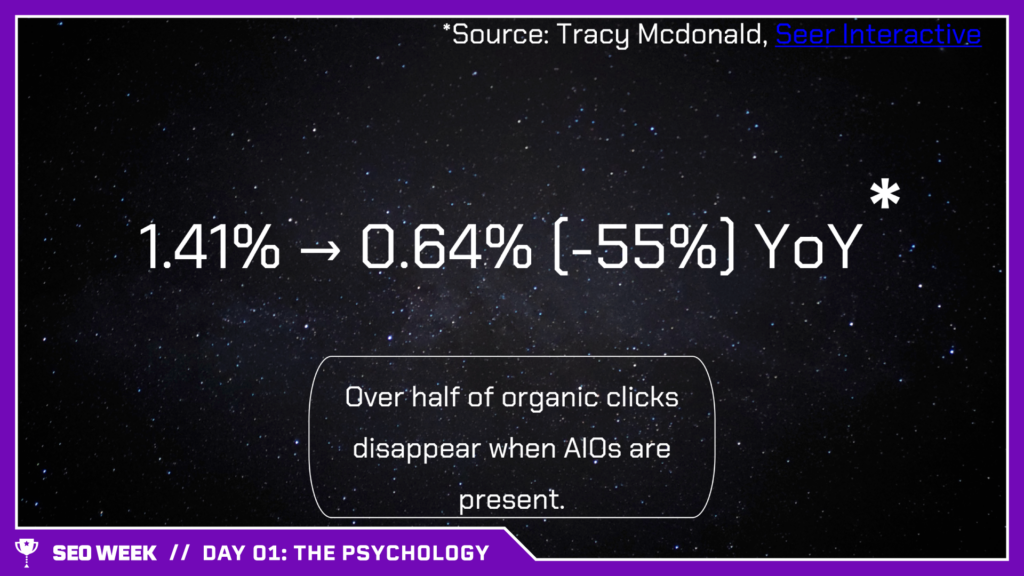
Important Takeaway
Shift your SEO strategy from chasing traffic to maximizing business impact by prioritizing content that drives conversions, not just visibility.
SEO success in a post-AI landscape, where traditional metrics like traffic often mislead, means focusing on the content that actually delivers measurable value.
Mini Glossary
- Brown Dwarfs (A brilliant Bianca-ism): URLs with low traffic but high conversion rates are hidden gems with untapped potential that can be optimized for better performance.
- Copernican Shift: A metaphor for a fundamental change in perspective; here, redefining SEO success from visibility-based to value-based, similar to Copernicus changing the view of the universe.
- Performance Dip Buckets: Diagnostic categories used to sort and address the causes of declining content performance, enabling faster editorial or technical fixes.
- Systemic Volatility: Fluctuations in traffic caused by external factors (e.g., algorithm changes, AI overviews) that require thoughtful analysis rather than reactive panic.
- Middle-to-Bottom Funnel Content: Content that targets users closer to a conversion decision, becoming increasingly valuable as AI overviews absorb top-of-funnel (informational) traffic.
The Evolving Content Marketing Playbook

Ross Hudgens, Founder & CEO at Siege Media, focused on the evolving role of SEO and content marketing in today’s competitive digital landscape. He highlighted the increasing importance of brand authority over traditional domain authority metrics, emphasizing that brands with strong reputations are more resilient in the face of negative PR events.
Ross argued that SEO strategies should shift toward product-focused approaches, including user experience optimization and conversion rate improvements, rather than solely relying on technical SEO. He also discussed the need for collaboration across disciplines and the integration of digital PR efforts that genuinely amplify brand presence.
Additionally, Ross emphasized the importance of regularly updating keyword research and adapting to rapid changes driven by AI and consumer behavior shifts.
“That’s the single stress test I think every SEO should ask themselves today and forever: would our company create this content if SEO didn’t exist today?”
- Ross Hudgens
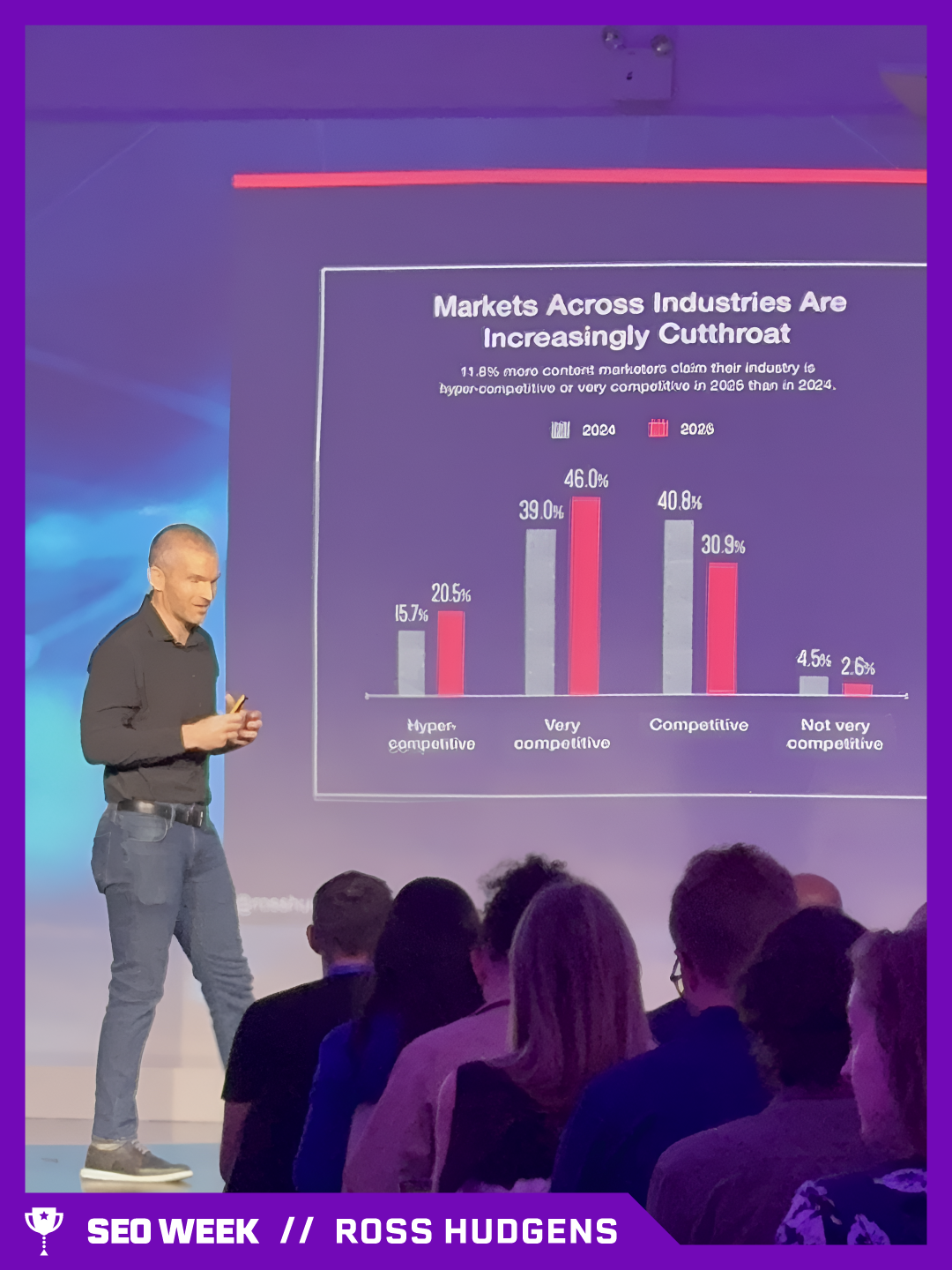
Key points
- Brand Authority Is the New SEO Power Metric: Traditional metrics like Domain Authority are giving way to Brand Authority as a more reliable signal of ranking potential. Moz’s correlation studies highlight that brands with strong public perception and awareness consistently outperform higher-domain-authority sites with weaker brand signals. This shift emphasizes the need for SEO strategies that support brand building—not just technical optimization. Moreover, growing brand strength naturally leads to increases in non-branded traffic and long-term visibility.
- From Link Building to Brand Amplification in Digital PR: Digital PR is evolving beyond simple backlink acquisition. The focus now should be on amplifying brand presence through compelling, product-aligned storytelling that builds trust and recognition—especially in an era where AI-driven search results prioritize relevance and authority. Metrics like brand lift, engagement, and product alignment are increasingly more meaningful than raw link volume, helping to strengthen the brand’s voice in the market.
- SEO’s Role in Product Experience and Cross-Team Strategy: SEO must become embedded within product experience, UX, and CRO strategies. That means working cross-functionally with product, design, and engineering teams to ensure SEO recommendations enhance, not conflict with, user experience. Techniques like A/B testing and user behavior analysis are critical to refining pages that serve both search engines and humans. This is especially vital in programmatic SEO, where tools like Opiversal help generate scalable, intent-aligned content.
- Quarterly Agility in Research and Strategy: The old practice of yearly keyword research is no longer sufficient. With AI altering search experiences and consumer behavior shifting faster than ever, brands must adopt a quarterly refresh cycle for keyword strategy. This level of agility ensures content strategies stay relevant, informed by the latest SERP features, user intent changes, and new AI tools.
- Reputation Management and the Risk of Negative PR: In today’s search landscape, negative PR can directly impact rankings and CTR, making brand reputation a critical part of SEO strategy. A crisis in the public eye doesn’t just harm perception – it can reduce click confidence and depress visibility. Investing in proactive brand management is no longer just PR’s job; it’s essential to holistic SEO performance.
- Content That Serves the Brand Beyond SEO: Not all content should be created for keywords. Instead, SEO teams should support value-driven content – like sales enablement materials, thought leadership, and product education – that drives real business outcomes. Even when such content isn’t optimized for search, its impact on conversion, brand recall, and customer experience makes it a vital part of the content ecosystem.
- Visibility Isn’t Just Rankings – It’s Accessibility: SEO success isn’t limited to where your content ranks on Google. Ensuring your best content is easily discoverable via smart site architecture and distribution channels is equally critical. In a saturated digital landscape, content that lives in the right place and reaches the right audience, regardless of SERP performance, builds stronger brand equity and user engagement.
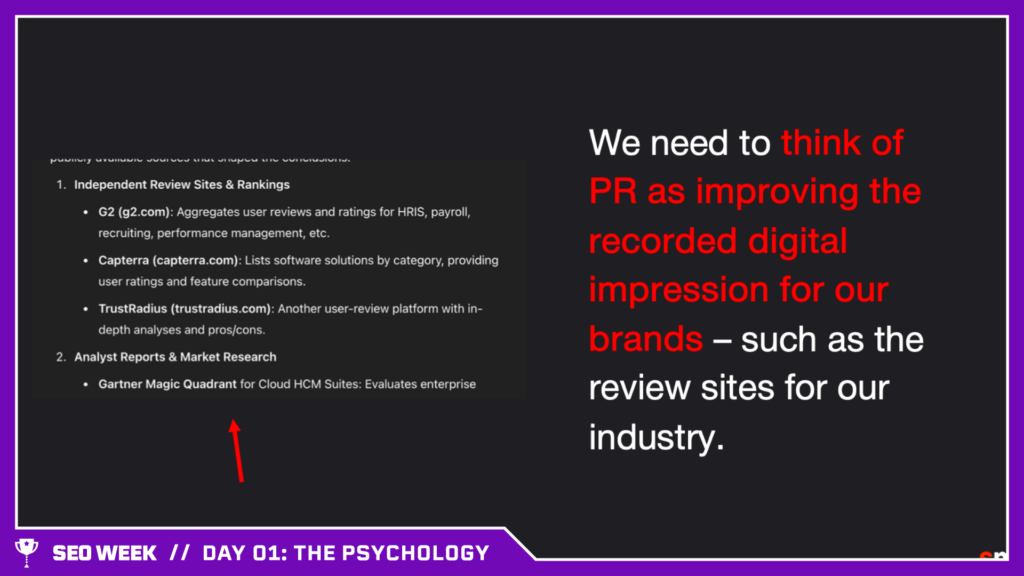
Important Takeaway
SEO now depends more on brand authority and user experience than technical tactics – create content that matters, even without search engines. Focus on activities that would naturally add value to businesses, irrespective of SEO considerations, ensuring sustainable brand growth and non-branded traffic increases.
Mini Glossary
- Product SEO Focus: An approach that centers SEO strategy on optimizing the user experience, product pages, and conversion rates, instead of just technical site improvements.
- Cross-Disciplinary Collaboration: Working with design, development, and product teams to implement user-focused strategies like A/B testing and UX improvements for better SEO outcomes.
- Efficiency in Competitions: A strategy focused on maximizing the ROI of SEO and brand efforts in a highly competitive landscape with fewer high-value search opportunities.
AI is Rewiring Your Search Behavior

Garrett Sussman, Marketing Director at iPullRank, was all about how AI is reshaping search behavior. He focuses on its impact on psychology, search algorithms, and content strategies, while highlighting the dual nature of AI. Its potential to revolutionize search while also introducing challenges like bias, hallucinations, and privacy concerns.
Garrett emphasized the inevitability of conversational search and multimodal AI interfaces, which are becoming the norm, and addressed the ethical implications of AI-generated content, particularly regarding bias and the role of editorial oversight in shaping search results.
Additionally, he discussed the importance of understanding audience identities and mapping conversational search journeys to adapt content strategies effectively.
“Search is a modern marvel...It's so hard right now to have this strong opinion about how AI is ruining the world and at the same time AI is the best thing that's ever happened to search.”
- Garrett Sussman
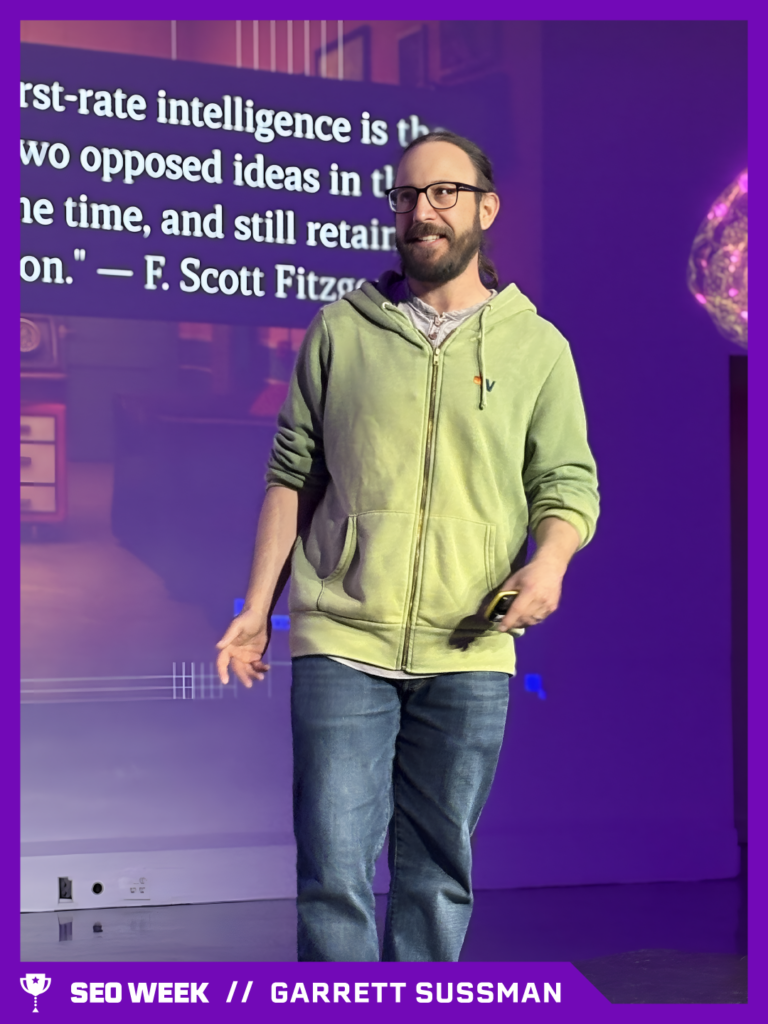
Key Points:
- AI as a Powerful but Imperfect Force: AI represents both unprecedented innovation and a source of serious ethical and operational challenges. While tools like ChatGPT are transforming how users search and consume content, they also introduce risks related to bias, misinformation, and privacy. Techniques such as human-in-the-loop training and value-aligned frameworks are essential for mitigating these issues. Legal constraints, especially in regions like the EU, add further complexity, slowing the deployment of advanced AI features and raising questions about long-term scalability and regulation.
- The Rise of Conversational and Multimodal Search: Conversational search is no longer a future trend…it’s here. As AI assistants become more intuitive, search experiences are evolving into natural, dialogue-based interactions across text, voice, and visuals. This multimodal shift demands new content strategies that can respond to personalized and contextually aware queries. Marketers must move beyond static keywords and embrace the probabilistic, evolving nature of how users express intent in real-time conversations.
- Search Behavior, Bias, and AI Interpretation: Human psychology plays a significant role in how people interact with AI search systems. Confirmation bias, default reliance on dominant platforms like Google, and the emotional tone of user input all influence both the questions asked and the answers received. AI’s perceived “personality” varies by platform, which subtly shapes trust, satisfaction, and content perception – making it critical for search professionals to understand the psychological and cultural dynamics that shape search behavior.
- Relevance Engineering and the New Content Frontier: To thrive in this new landscape, marketers must embrace Relevance Engineering – a cross-functional discipline that integrates SEO, UX, NLP, and content strategy. Success depends on creating content that aligns not just with search engines, but with human needs, user intent, and AI interpretation. That means designing for context, adaptability, and relevance, not just visibility. A scientific, iterative mindset is crucial: continuous testing, learning, and adjusting are the only ways to stay competitive in an AI-driven market.
- Adaptability as Strategy: Future-Proofing for What’s Next: The one constant in AI and search is change. To future-proof strategies, teams must build adaptability into their workflows. That includes conducting regular experimentation, revisiting assumptions, and embracing a mindset that’s comfortable with uncertainty. As platforms evolve and market dynamics shift, those who can evolve their strategies quickly – based on data, ethics, and user insights – will be best positioned to lead in the age of AI-first search.
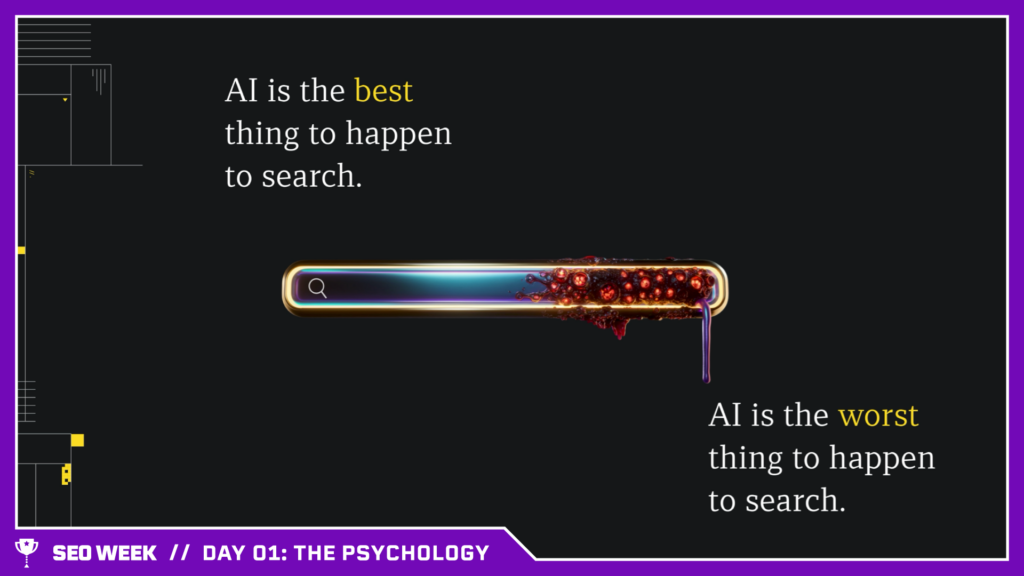
Important Takeaway
AI is revolutionizing search with conversational and multimodal interfaces, but it also brings challenges like bias and privacy – demanding ethical oversight and adaptable, audience-focused strategies. Despite the rapid evolution of AI, marketers and content creators should embrace a scientific mindset, continuously testing and iterating to stay ahead in this dynamic landscape.
Mini Glossary
- Human-in-the-Loop (HITL): A model where human oversight is involved in AI training or decision-making processes to ensure quality, accuracy, and ethical outcomes.
- Probabilistic Recommendations: AI-generated suggestions based on statistical predictions of what users are likely to want or find relevant.
- Constitutional Values (in AI): Guiding principles embedded into AI systems to align their outputs with human ethics and democratic norms.
The "Other" AI That is Hurting Your Organic Traffic

Wil Reynolds, Founder & CEO at Seer Interactive and an experienced content strategist, delivered a thought-provoking presentation addressing the challenges of maintaining authenticity in SEO and content creation amidst the rise of AI-driven tools.
Wil emphasized the importance of prioritizing genuine engagement over mere rankings and highlighted the disconnect between traditional SEO metrics and actual user behavior. Wil’s insights on how authenticity, personalization, and understanding human intent can lead to better outcomes in content creation and marketing were important.
Wil also discussed the pitfalls of relying solely on AI-generated content and urged the audience to focus on building meaningful connections with their audiences.
“Search engines penalize authenticity. The more unique you are about speaking your truth, the less you show up and the less traffic you get. And what do they reward? Being like everybody else.”
- Wil Reynolds

Key points
- Authenticity, Storytelling, and Ethical Connection Drive Long-Term Value: Chasing rankings can be a short-term game, but authenticity, ethical alignment, and human-centric storytelling build enduring brand equity. Wil uses examples like Nudie Jeans to emphasize how brands that stay true to their values, and communicate them effectively, can stand out in crowded markets. Building loyal fans who resonate with your mission and content creates deeper engagement and higher conversion rates than optimizing for fleeting visibility alone.
- Themes Over Keywords: Resonance Beats Precision: Wil advocates for moving away from traditional keyword-centric approaches toward theme-based content strategy. By focusing on broader semantic relevance and user needs rather than individual phrases, marketers can create more meaningful, AI-friendly content that performs better in today’s evolving search landscape. This also allows for more natural, cohesive storytelling that aligns with how users actually think and search.
- AI with Reasoning and Transparency Is the Future of Tools: Not all AI is created equal. Tools like Deepseek are emerging as next-generation platforms by offering transparency and contextual reasoning, setting themselves apart from generic AI outputs. As AI becomes more embedded in marketing workflows, personalization, memory, and interpretability will be key differentiators – pushing the industry toward smarter, more responsible automation.
- Metrics vs. Reality: Focus on ROI, Not Vanity: Traditional SEO metrics can be deceiving. A piece of content may drive high traffic but deliver little revenue, while a low-traffic page might be a conversion powerhouse. Wil stresses the importance of joining paid and organic data to isolate what’s really driving ROI. Prioritizing revenue over traffic, and conducting deep data analysis to spot underperforming keywords, enables more strategic decision-making and a clearer view of success.
- The Human Element Still Wins: Despite advances in AI and data integration, the human touch remains irreplaceable. Authentic engagement—through storytelling, emotional resonance, and personalization—continues to forge stronger relationships with audiences than any algorithmic tweak. The key takeaway: use AI to enhance, not replace, your brand’s human voice.
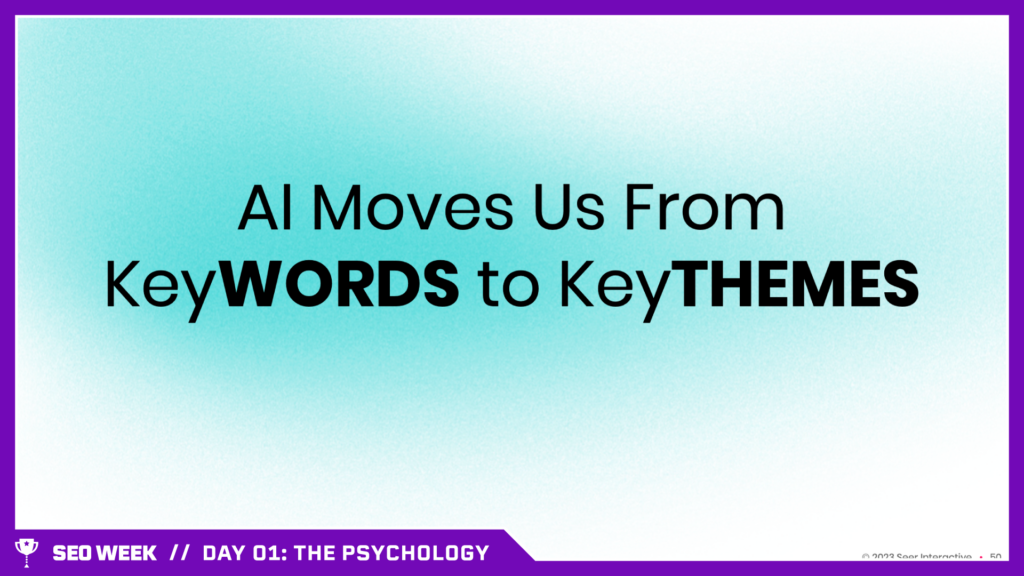
Important Takeaway
Authentic, human-centered content drives deeper engagement and long-term success, beyond just rankings or AI-generated output. The future of SEO is a shift toward AI-driven personalization; stay away from superficial content generation while continuing to adapt. Advocate for a strategy that prioritizes genuine connections over fleeting trends, ensuring sustainable growth in an increasingly AI-centric world.
Mini Glossary
- Semantic Relevance: How well content matches the meaning or context of a user’s search query, not just the exact keywords.
- Paid and Organic Data Integration: Combining data from paid advertising and organic search efforts to make better marketing decisions.
- Thematic Optimization: Creating content based on broader subjects or themes rather than just specific keywords.
- Ethical Marketing: Promoting products or services in ways that align with moral values and responsible business practices.
Stop Doing Marketing

Devin Bramhall, Growth Advisor & Podcast Host of Don’t Say Content, a renowned storytelling expert, and former CEO of Animals, presented a compelling talk that made a lot of us sit up – “Stop Doing Marketing”?? But…that’s my job?! I really, really enjoyed her talk.
She challenged conventional marketing practices by emphasizing that marketing, particularly content marketing, is often misaligned with its intended purpose of driving business growth. Instead of focusing on traditional activities, she advocated for a strategic mindset that prioritizes outcomes over tactics.
Devin shared several examples, such as improving processes, optimizing pricing strategies, and leveraging existing resources, to demonstrate how businesses can achieve growth without relying solely on marketing efforts. She highlighted the importance of understanding a company’s unique strengths and constraints while fostering innovation and adaptability.
Ultimately, she urges us marketers to shift our focus from adhering to established playbooks to creating strategies that deliver measurable and impactful results.
“Marketing isn’t even always the best solution to growth.”
- Devin Bramhall
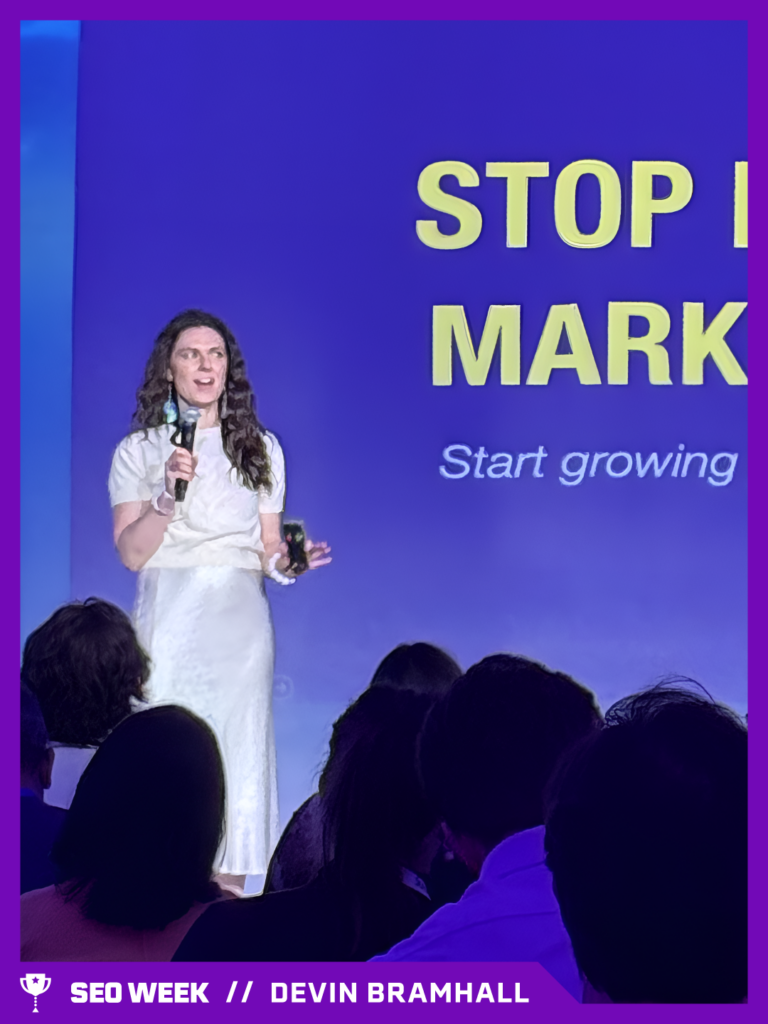
Key points
- Growth Is Bigger Than Marketing: While marketing is a key driver, it’s only one part of a much broader growth ecosystem. Solely focusing on content or campaigns can create blind spots, ignoring critical elements like internal operations, customer experience, or product innovation. Real growth comes from integrating marketing within a holistic, company-wide strategy that aligns with measurable business outcomes, not just visibility metrics.
- Outcome-Driven, Not Activity-Driven: Too many businesses mistake busyness for effectiveness. The goal should be to prioritize strategic outcomes over routine activities, focusing only on what moves the needle. This means abandoning generic playbooks and best practices in favor of tailored strategies built on logic, experimentation, and what actually works for your specific business environment.
- Cross-Functional Collaboration Fuels Innovation: Teams often underestimate the value of their internal talent and institutional knowledge. By breaking down silos and encouraging collaboration across departments—whether in engineering, customer service, or ops—companies can unlock creative, scalable solutions. These internal partnerships often lead to more efficient workflows and innovations that are difficult for competitors to replicate.
- Embrace Chaos and Complexity in the Customer Journey: The traditional funnel is outdated. Today’s customer journey resembles a subway map, with multiple touchpoints, detours, and feedback loops. Embracing this non-linear reality requires adaptability, humility, and a willingness to design systems that accommodate the unpredictability of human behavior – rather than forcing order where there is none.
- Adaptability and Resourcefulness Over Rigid Playbooks: Like the migratory eel that thrives through constant change, companies must develop a mindset rooted in adaptability and creative problem-solving. This involves optimizing processes, leveraging unique strengths, and approaching challenges from unconventional angles. Success often comes from identifying the smallest set of necessary actions that can yield the greatest possible impact – with the least effort.
- Mindset Before Tactics: The foundation of sustainable growth isn’t the latest tool or framework, it’s a shift in mindset. Moving away from a culture of copying others toward building personalized, values-driven strategies is what truly sets companies apart. When teams are empowered to think critically, embrace experimentation, and align their efforts with the business’s core strengths, growth becomes not just possible, but inevitable.
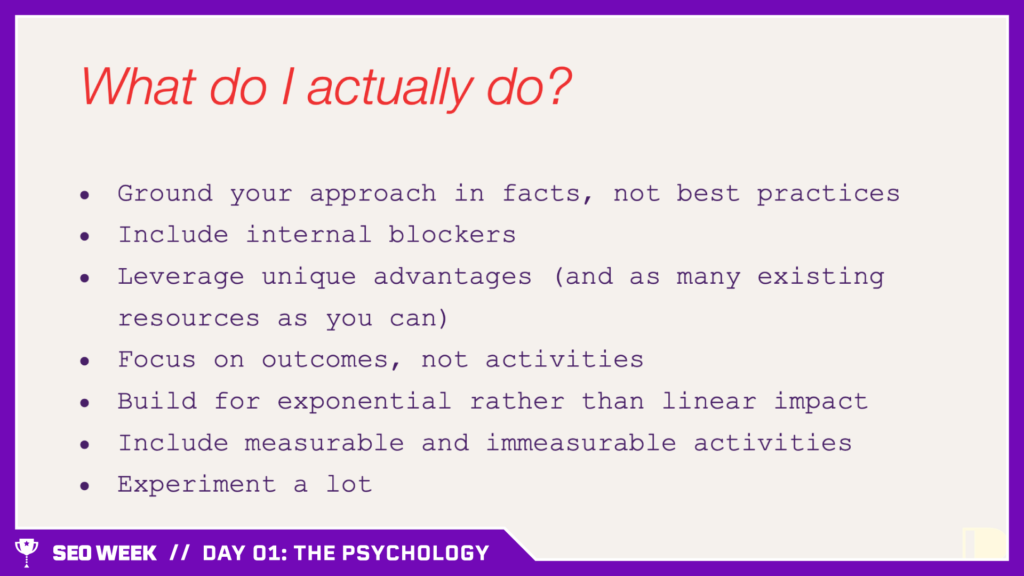
Important Takeaway
Marketing isn’t always the best path to growth – focus on strategic, outcome-driven actions that leverage your company’s unique strengths and foster adaptability over following traditional playbooks. While data is essential, intuition and creativity play equally vital roles in developing effective strategies. A good strategist focuses on creating an unfair advantage for their company, disregarding fairness in pursuit of superior results.
Mini Glossary
- Subway Map Model (Customer Journey): A complex, non-linear model showing multiple paths customers can take, like subway routes.
- Mindset Over Tactics: Prioritizing the way you think about problems and strategies instead of just copying standard methods.
The Lessons I Haven't Shared on LinkedIn from Offsite SEO - Earning Over 50K Links Through Content Marketing

Carrie Rose, Founder & CEO at Rise at Seven, talked about addressing the misconception that “brand is the new SEO” and “SEO is dead.” Carrie discussed how SEO remains crucial and emphasized the importance of category signals over mere brand signals.
Using examples from her agency’s work with brands like Red Bull, Ninja, and Pooky, she explained how SEO strategies have evolved to focus on off-page signals, including links, content relevance, and category signals.
Carrie also touched on the role of digital PR in creating demand, the impact of brand authority, and the shift toward affiliate-driven content. Her insights underscored the need for SEOs to adapt to changes in search algorithms and media practices while focusing on delivering value to audiences.
“Google is looking for category signals - it’s about training the internet and your audience to associate your brand with your category.”
- Carrie Rose
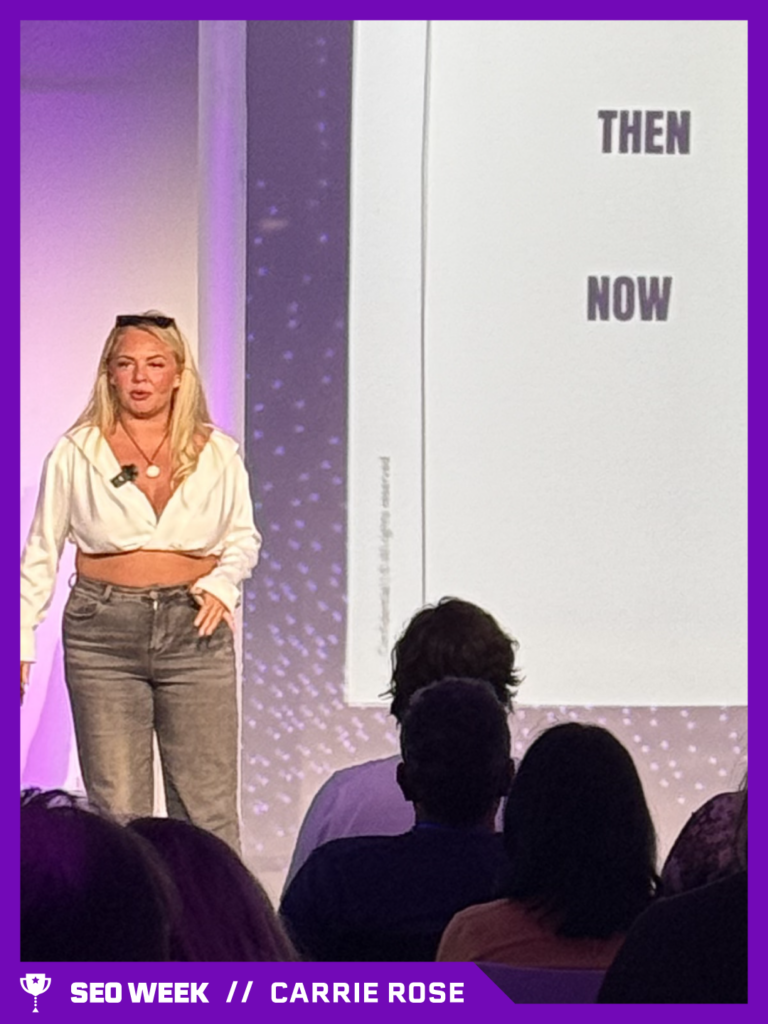
Key points
- Off-Page SEO Is Evolving—and It’s More Important Than Ever: It now accounts for roughly 60% of SEO opportunity, but it’s no longer just about acquiring backlinks. Today, it’s about building authority, trust, and category relevance. Modern SEO must focus on shaping how a brand is understood in context, not just how often it’s mentioned.
- Category Leadership Beats Brand Recognition in Search: Google increasingly prioritizes category signals over brand signals, recognizing entities that demonstrate clear expertise and association with a niche. SEOs should focus on positioning brands as category leaders by aligning them with specific terms across multiple platforms and campaigns.
- Social Media and SEO Are No Longer Separate Worlds: Platforms like TikTok are generating search volumes that rival or surpass Google in certain verticals. SEOs need to collaborate with social teams to guide keyword targeting and optimize creator content for search discoverability.
- Digital PR Is the New Link-Building, and It Fuels Demand Creation: Viral, media-friendly campaigns are one of the most effective ways to generate authoritative backlinks and organic traffic. These aren’t just content assets, they’re engines of category association and ranking growth.
- SEO Success Now Requires Strategic Real Estate and Psychological Savvy: Publishers are pivoting to affiliate-driven models, which limit followed link opportunities but open the door to new kinds of visibility. SEOs should aim to secure valuable placement within trusted media properties – not just links, but brand mentions and features. Additionally, because human memory is limited, brands must build multiple touchpoints across digital ecosystems to create lasting category associations. It’s not just about ranking once, it’s about staying top-of-mind across platforms.
- Cross-Functional Collaboration Is the Future of SEO: SEO can no longer operate in a silo. Success now requires working closely with PR, content, and social media teams to tap into trending topics, craft search-optimized headlines, and amplify visibility across channels. These collaborations enhance both reach and revenue potential, turning traditional PR wins into tangible SEO gains.
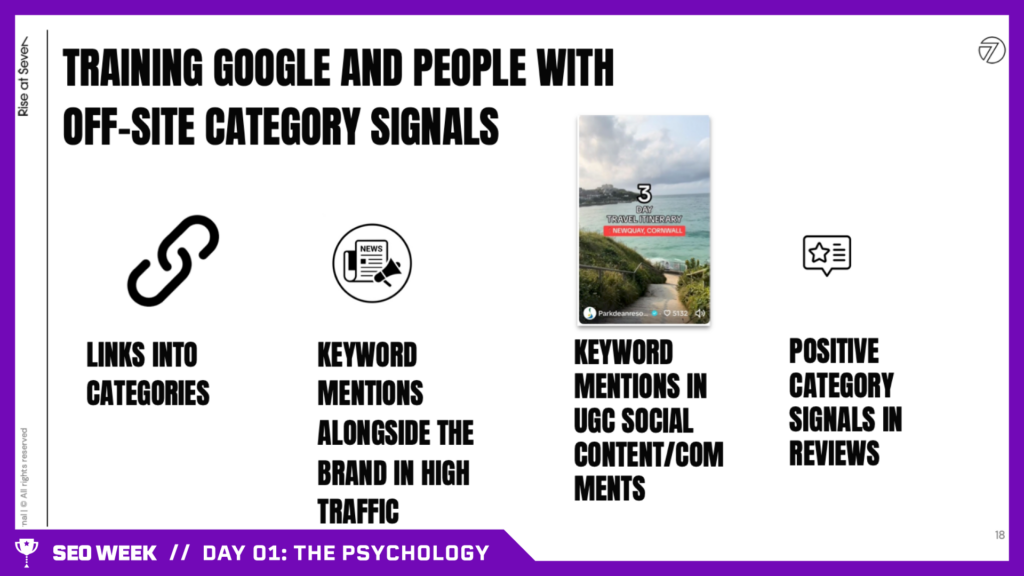
Important Takeaway
SEO isn’t dead; it’s evolving to focus on building strong category signals that link brands to their niches, using off-page SEO like digital PR and authority signals to boost search visibility.
A collaboration between SEO and PR, with teams aligning efforts to maximize visibility, is the way forward in this new space. Training sessions can bridge gaps between these disciplines, ensuring both teams understand the evolving landscape of search and media.
Mini Glossary
- Category Signals: Indicators that show a brand’s expertise and relevance within a specific market or niche, helping Google associate the brand with that category.
- Brand Signals: General recognition or awareness of a brand, which is less important than category-specific relevance in SEO.
Your Most Valuable Asset: Why You’re Not Using It (And How to Fix That)

Brie Anderson, Owner at BEAST Analytics, emphasizes the importance of leveraging data effectively to maximize Return on Investment (ROI) for businesses. She highlights that while data is often referred to as the most valuable asset, its true potential is realized only when used strategically.
Brie discusses the necessity of creating a tracking plan to define success metrics, ensuring data is collected accurately, and making it accessible and understandable. She advocates for tailoring data presentation to meet the needs of various stakeholders, such as clients, bosses, and internal teams.
Brie also stresses the importance of identifying trends and outliers in data, using visualization tools like Looker Studio to simplify complex datasets, and creating two distinct types of reports – one for internal analysis and another for external stakeholders. She encourages continuous testing and innovation to adapt to a rapidly changing market.
“Data is your most valuable asset. But it only matters if you actually use it. We have to stop cherry-picking a few metrics and start building tracking plans that show real success - because it’s 2025 and the economy demands that we do better than guessing.”
- Brie Anderson

Key points
- Define Success Early and Track With Purpose: Before launching any initiative, it’s critical to establish clear success metrics and a well-structured tracking plan. This upfront clarity ensures that all data collected aligns with strategic goals, prevents wasted effort, and lays the groundwork for meaningful analysis. Aligning your analytics with what actually matters to the business ensures stakeholders stay focused on performance, not noise.
- Use Data to Tell Stories, Not Just Numbers: Data is only valuable when it’s actionable. That starts with identifying trends, anomalies, and patterns – but it doesn’t end there. Always ask “So what?” to tie insights to real strategies. Tools like Looker Studio are essential in simplifying complex datasets and making insights easy to interpret, helping teams move from analysis to action faster.
- Design Dual-Purpose Reporting Systems: Different audiences need different levels of detail. Build internal reporting systems for in-depth analysis and diagnostics, and external reporting dashboards that deliver concise, high-impact insights tailored to clients or executive stakeholders. This dual approach supports transparency, builds trust, and ensures everyone gets the data they need – without being overwhelmed.
- Experiment Relentlessly and Embrace Serendipity: The best strategies often emerge from testing, iteration, and unexpected successes. Foster a culture where experimentation is continuous and unexpected wins (“happy accidents”) are recognized, analyzed, and scaled. Innovation doesn’t always come from planned outcomes; sometimes, it’s about being ready to double down on what’s already working in surprising ways.
- Simplify for Stakeholders, Prioritize for Impact: Data overload is real. To keep stakeholders engaged and decisions focused, highlight the most critical insights first, avoid vanity metrics, and connect performance directly to business outcomes. Prioritize initiatives that offer the highest potential return on investment, and adjust your tactics as the market evolves, ensuring your team remains agile, aligned, and effective.
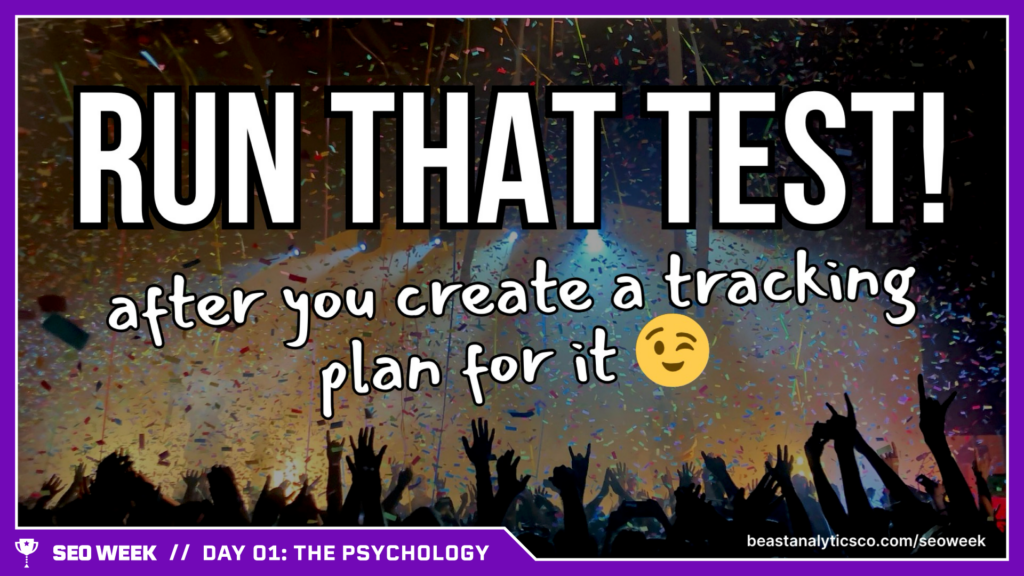
Important Takeaway
Data only delivers value when used strategically, through clear tracking plans, smart analysis, and tailored reports, to turn insights into actions that boost ROI and outsmart guessing in today’s market.
Maintain a culture of constant testing to ensure continuous improvement – it ensures businesses remain adaptable and responsive to market changes.
Mini Glossary
- Tracking Plan: A detailed framework that defines success metrics and guides accurate data collection aligned with business goals.
- Dual Reporting Systems: Creating two types of reports: one for deep internal analysis and another simplified version for external stakeholders.
Stop Chasing Conversions: Win More Customers with an Emotion-first CRO Strategy That Actually Works

Talia Wolf, Founder & CEO at Getuplift, talked about the importance of prioritizing emotions in conversion rate optimization (CRO). She critiqued the traditional approach to CRO, which often involves a futile cycle of random A/B testing and copying competitors.
Talia argued that this outdated method fails to address the root cause of underperformance – ignoring the emotional drivers behind consumer decisions. Drawing on neuroscience and psychology, she explained that every decision, whether personal or professional, is rooted in emotion.
Talia introduced her Emotional Targeting framework, which shifts the focus from superficial tactics to understanding customers’ true motivations, such as self-image and social image. Her talk concluded with actionable insights, including emotional-based tests that marketers can implement immediately.
“Every single decision in life is based on emotion. Yes, we will rationalize it later, but there's a primary emotion in there. In fact, there are studies that prove that without emotion, we lack the ability to make any kind of decision."
- Talia Wolf
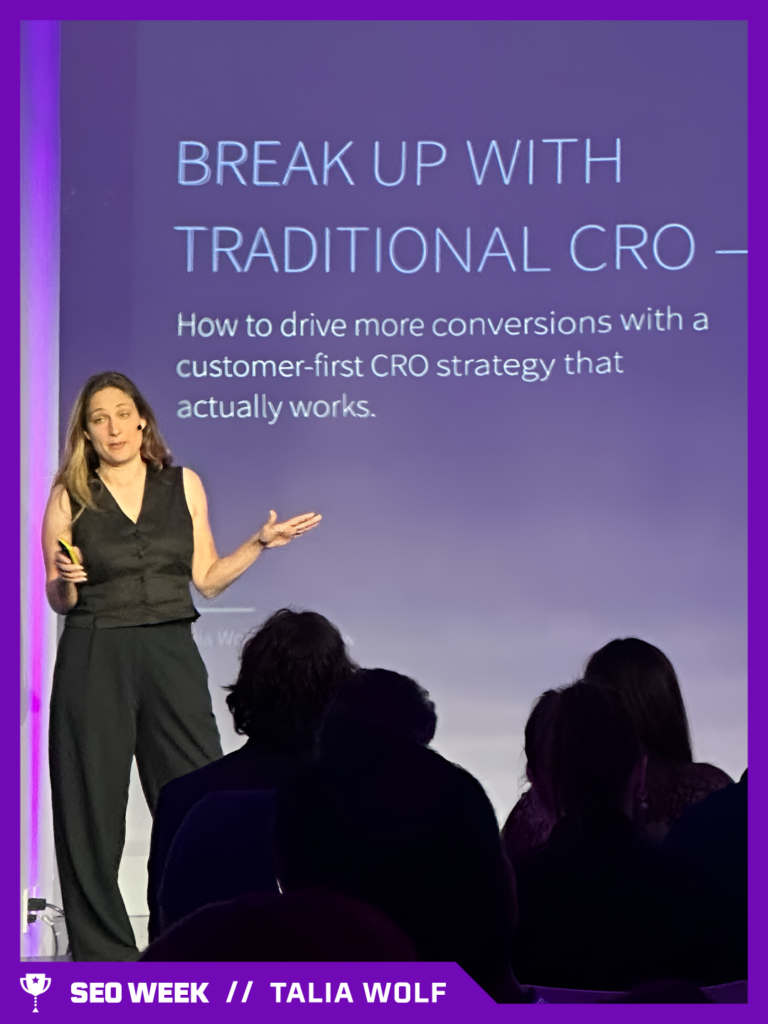
Key points
- Emotions Drive Decisions, Even in B2B: Neuroscience confirms it: people make decisions emotionally, then justify them with logic. This holds true in B2B as much as B2C. Customers care about how a brand or product makes them feel – about themselves (self-image) and in the eyes of others (social image). Brands like Shopify and Intel succeed not just by selling features, but by aligning with customers’ aspirations, pride, and need for validation. Positioning customers as the heroes of their own journeys, not just users of your product, creates deeper, lasting connections.
- Stop the Testing Treadmill and Start With Strategy: Many marketers get stuck in what’s been called the “deadly hamster wheel” – endless A/B tests and copied tactics with little strategic thought. CRO isn’t just a toolkit; it’s a business-critical strategy that unites marketing, SEO, and sales around solving real problems. The most impactful experiments answer important questions about relevance, resonance, and emotional alignment, not just button colors and headlines.
- Emotionally Intelligent Content Outperforms Feature Lists: Content that simply describes features fails to engage. What truly resonates is messaging that addresses emotional pain points and outcomes. Customers want to know: “How will this make my life better?” Testing pain-focused vs. outcome-focused messaging in emails and ads can reveal which emotions drive engagement and action. The goal is not to describe a product, but to tell a story where the customer overcomes obstacles and succeeds – with your brand by their side.
- Use Emotional Audits to Align Every Touchpoint: A strategic emotional audit looks beyond analytics and asks: Does each touchpoint make the customer feel understood, empowered, and confident? From landing pages to email nurture sequences, brands need to uncover blind spots and tailor every interaction to reflect the customer’s emotional journey. When relevance and resonance are aligned, the entire experience becomes more persuasive, trustworthy, and effective.
- Customer-Centric Research Unlocks True Optimization: To truly optimize, you must understand the “why” behind customer behavior. That requires deep customer research, not guesswork. The Emotional Targeting Framework shifts the focus from the product to the person, uncovering motivations, fears, and desires that drive purchasing. When you align your value proposition with these deeper emotional truths, you create not just conversions, but loyalty and advocacy.
- Fail Forward With Purposeful Experimentation: Not every test will boost conversions, and that’s okay. Meaningful experiments, even those that “fail,” reveal valuable insights about your audience and messaging. By embracing a test-and-learn culture, teams foster continuous improvement and innovation. The goal of CRO isn’t perfection – it’s progress, understanding, and customer alignment.
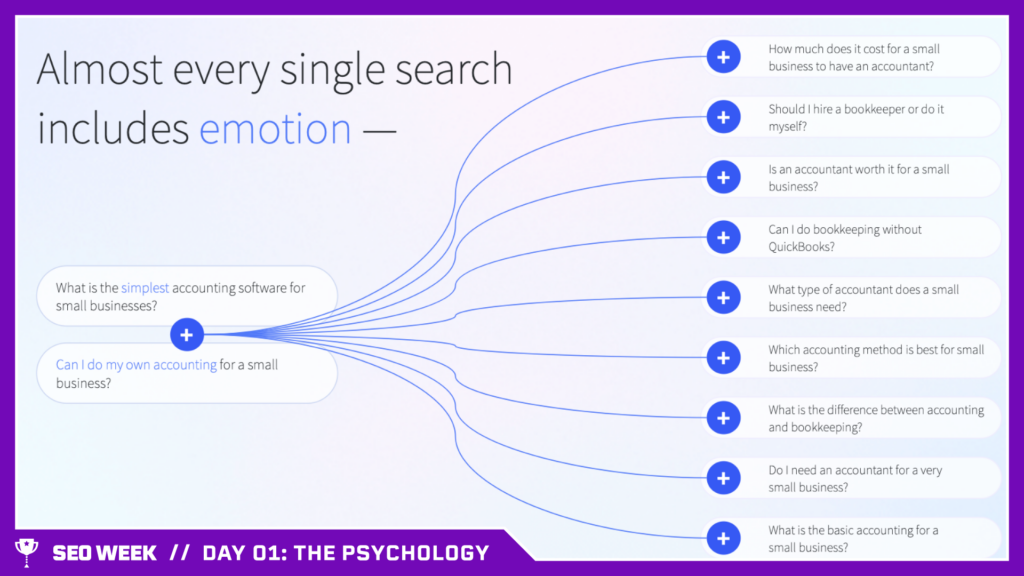
Important Takeaway
Effective CRO hinges on prioritizing customers’ emotions rather than relying on random A/B testing or copying competitors. By understanding the emotional drivers behind decisions, such as self-image and social image, and using an Emotional Targeting framework, businesses can create meaningful, customer-centered experiences that lead to sustainable growth and stronger connections.
Mini Glossary
- Emotional Targeting Framework: A CRO approach that focuses on understanding and leveraging customers’ true emotional motivations (like self-image and social image) rather than just product features or superficial tactics.
- Emotional Drivers: The underlying feelings and motivations that influence consumer decisions, often more powerful than logical reasoning.
- Deadly Hamster Wheel: A metaphor for the futile cycle of random A/B testing and copying competitors without addressing deeper emotional needs.
- Hero Mentality: A marketing approach that positions customers as heroes overcoming challenges, fostering a stronger emotional connection.
From Villains to Heroes

Dawn Anderson, Principal Consultant & Managing Director at Bertey, had a lot to say on the evolution of information retrieval (IR) and its intersection with SEO. She highlighted the outdated perception of SEO within the academic IR field and emphasized the current challenges faced by search engines as they transition toward generative information retrieval.
Dawn argued that the search results have deteriorated due to the rapid shift in technology, particularly generative AI, which relies heavily on patterns rather than facts. Despite this, she stressed that SEO professionals still play a crucial role in assisting search engines by ensuring consistency, improving equability disambiguation, and contributing to knowledge graphs.
SEOs are not villains but heroes who help search engines navigate their existential crisis.
“SEO pros are the unsung heroes, navigating the chaos of search updates and algorithm changes to keep websites visible and thriving.”
- Dawn Anderson
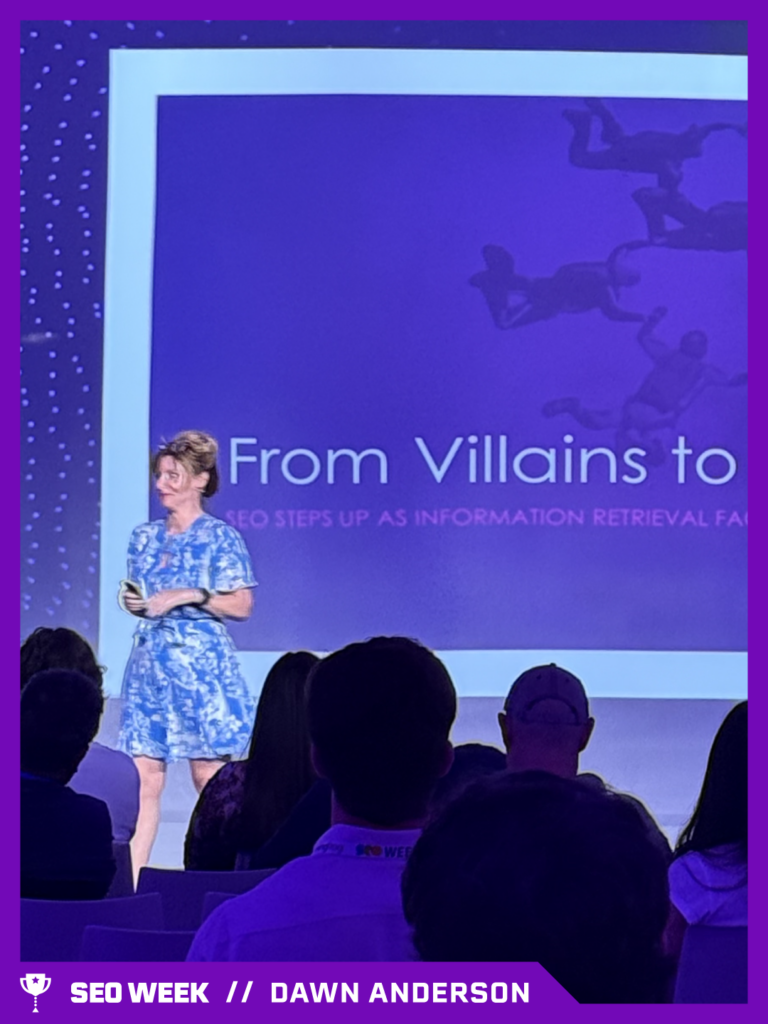
Key points
- Generative AI Is Reshaping the Search Paradigm: We’re witnessing a fundamental shift in how search operates, moving from traditional information retrieval based on indexing and keyword matching to generative information retrieval. Large language models (LLMs) now generate responses based on patterns rather than retrieving documents directly. While groundbreaking, this approach introduces instability, hallucinations, and a decline in result quality, underscoring the need for structured, reliable input and human oversight.
- SEOs Are Essential Partners in the Age of AI Search: Despite historical tension between the SEO and IR (information retrieval) communities, SEOs bring critical expertise to the table. From recommending clustering and content structuring strategies to ensuring data consistency and content clarity, SEO professionals are increasingly vital to refining AI-driven search systems. Dawn’s position is clear: SEOs are not villains but heroes, helping search engines navigate the growing pains of this technological transition.
- Human Judgment and Ethical Guardrails Remain Crucial: As generative models reshape how users interact with search, human input is more important than ever. SEOs help bridge the gap between machine logic and real-world context, ensuring relevance, accuracy, and trustworthiness. Integrating ethical frameworks into these systems, especially in how content is surfaced and summarized, is a shared responsibility between technologists and marketers. Without this human guidance, search risks amplifying misinformation at scale.
- Consistency and Collaboration Are the New Imperatives: Generative IR systems rely on structured, stable input to perform well. That makes content consistency, accurate metadata, and semantic clarity indispensable – areas where SEO professionals excel. Rather than viewing SEOs as competitive manipulators of search, the IR field must embrace cross-disciplinary collaboration. When SEOs and AI researchers work together, the result is more relevant, more ethical, and more effective search experiences for users.
- Search Engines Face an Existential Crossroads, and SEOs Can Help: As generative AI forces a rethinking of how search engines operate, they face a real existential crisis. Can they balance speed, reliability, creativity, and monetization without sacrificing user trust? SEO professionals, with their deep understanding of user behavior, search intent, and content performance, are uniquely positioned to help guide this evolution – not just in visibility, but in the very architecture of search itself.
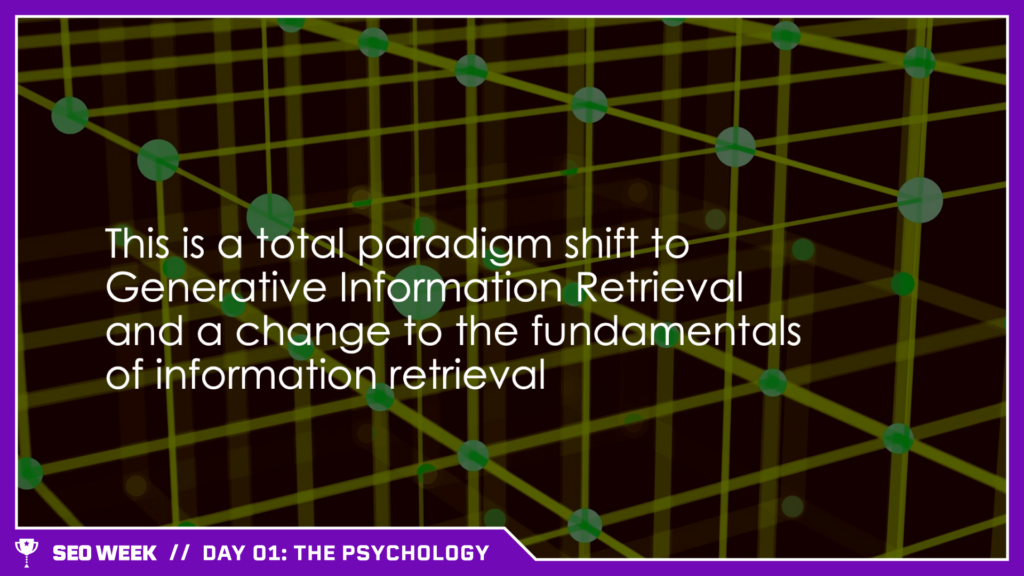
Important Takeaway
SEO professionals are essential allies in improving search as generative AI changes how information is retrieved. They help ensure data consistency, reduce errors, and support search engines through major challenges, proving they’re heroes, not villains, in the evolving search landscape.
Mini Glossary
- Generative Information Retrieval (IR): A new search method using AI to generate answers based on patterns instead of traditional indexing.
- Hallucinations: Errors in AI-generated search results where the system produces false or misleading information.
- Knowledge Graphs: Structured data used by search engines to understand relationships between concepts and improve search accuracy.
- Existential Crisis (Search Engines): The challenge search engines face adapting to AI-driven generative retrieval methods.
Evening Meetups - Demandsphere and SEOFOMO + Conductor
We had two separate meetups after Day 2 content – the DemandSphere Meetup held at Studio 23 and the SEO FOMO meetup co-hosted by Conductor held at the Conductor office.

Both events were filled with smart conversation, laughter, and some seriously sharp insights. The atmosphere was electric, as SEO pros gathered to connect, share ideas, and take a step back from the typical conference grind to really talk shop (and have some fun doing it).
At Demandsphere, we were honored to join CEO Ray Grieselhuber, the Flying Dinosaur (iykyk) Zach Chahalis, Digital Marketing Nerd Ian Lurie, and SEO Pro Jori Ford on one of the most engaging and entertaining panels we’ve seen. They covered everything from the evolution of SEO strategy to the growing role of AI and relevance engineering – and the audience energy made it all the more special. The mix of perspectives sparked fresh thinking, and the crowd’s questions added a whole new layer of depth.
Massive thanks to the whole DemandSphere crew for pulling off such a stellar event, especially Ray, Duncan Sze, and Zac Heinrichs. Their passion for building community and elevating the conversation around search and marketing was on full display.

At the Conductor Office, Aleyda Solis of SEOFOMO led meetup at Conductor and it was insightful, high-energy, and genuinely fun. Huge thanks to everyone who came out to make it such a memorable evening. From sharp panel discussions to impromptu conversations over pizza and drinks, the entire night was a celebration of the SEO community at its best.
The panel brought together some of the smartest minds in search to unpack trends, tactics, and the future of organic visibility. Whether it was conversations about AI in SEO, content strategy, or evolving SERP features, the takeaways were practical, thought-provoking, and refreshingly honest. Add in SEO quizzes, awesome giveaways, and a spread of snacks and drinks that kept the networking going strong, and you’ve got one of the most enjoyable events of the week.
Big shoutout to SEOFOMO and Conductor for hosting and curating an experience that blended education, community, and good vibes so effortlessly. This wasn’t just another meetup—it was a true highlight of SEO Week.
Events like these remind us how powerful it is when smart people come together to share, learn, and laugh. Already looking forward to next year’s SEO Week evening meetups!
Stay Tuned - Next Week We’ll Review Day 3: The ECOSYSTEM of SEO
What. A. Day. Day 2 of SEO Week was a total standout, especially if you’re someone who geeks out on content strategy, search behavior, and the human side of SEO (like I do!). The Psychology of SEO theme delivered in full force, and every session had me scribbling notes, nodding in agreement, and rethinking the way we approach content in an AI-first world.
This wasn’t just a day for taking notes, it was a day for rethinking how we approach content, conversion, and SEO in an AI-shaped world. Whether it was the call to embrace emotional targeting, the reminder to optimize for humans (not just search engines), or the push to align brand, UX, and product strategy, every session gave us new tools and perspectives to bring back to our work.
Huge thanks to everyone who made Day 2 unforgettable. Stay tuned next week for Day 3 – The Ecosystem of SEO

